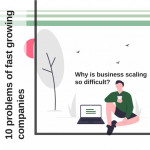Human resources are no longer limited to the back office dealing with endless piles of documents for some time now. Thanks to the Internet and modern technology, HR has completely transformed into a technologically advanced department that uses cloud-based solutions for employee management, recruitment, working time, onboarding, and much more.
The human resources department is usually a place of crazy activity. With the benefits of cloud-based HR software, HR professionals now have the tools to reduce and simplify administrative tasks such as payroll and record keeping. Instead, they can focus on issues that are very important in an era of fierce competition - such as employee engagement.
Since the early 2000s, there has been a significant shift from the first universal HR software, which has emerged in favor of specialized systems that can manage recruiting, training, evaluation, and other HR-oriented tasks. Cloud-based HR systems provide companies with computing power and the ability to survive and thrive in the information age.
Below, we will demonstrate how the following benefits of cloud HR software have improved the workplace.
Benefits of Cloud HR Software for HR Department
The most significant impact of cloud-based HR systems is the ability to bridge the HR team's gap and the organization’s rest. HR has traditionally always been in the back office, suffering from delayed information and a severe communication gap. Today, with a mandate to improve employee engagement and develop a workplace culture, HR must be at the forefront and the fore. Thanks to cloud computing, it is now possible. Data is centralized and more accessible, reporting is immediate, and analysis of trends and information is much easier and faster. With tools like BrainyHR, HR can effectively lead the way in making better decisions to improve onboarding, retention, and employee performance.
Less paperwork
The years of storing employee files in large filing cabinets are in the past. Thanks to the cloud-based HR software, all files can now be safely stored in the cloud and available immediately with Google Drive and Dropbox applications. As data is stored digitally, an HR employee can search for and print a file from a cloud-based HR solution in seconds.
Assessment and review of work results
One of the critical functions of an HR manager is the assessment of employee performance. Previously, the reviews involved endless paperwork and took a long time to collect the data. With cloud-based HR software, employee performance is automatically tracked in real-time. Data analytics uses built-in dashboards and reports, and machine learning. Cloud-based HR solutions help the team introduce appropriate new systems or provide additional training in a relatively short time.
Increased employee engagement
Cloud HR systems use big data and mobile technology to engage employees. For example, in minutes using BrainyHR, HR can send a pulse survey to employees to gather feedback on how they can better serve them. Cloud HR systems can also help you track working hours and manage employee payroll.
No doubt, HR teams have learned that employee engagement is a crucial source of competitive advantage over the past decade. Commitment drives high customer satisfaction, knowledge sharing, new applicant interest, business agility, and profitability. With the effective use of HR software BrainyHR, it can humanize the workplace and improve long-term retention.
Quick system implementation
HR software as a service is easy to implement and manage. Based on end-users’ feedback, such deployment is more straightforward than standalone or legacy HR systems. With HR software as a service, you don't have to worry about security updates or maintenance as a SaaS provider manages these tasks. In the case of BrainyHR, the implementation and commissioning of the system takes only a few weeks.
Solutions
Cloud-based HR systems offer more value for lower upfront costs than proprietary human resource management software. Once deployed, cloud solutions immediately start generating decent returns, including better data and time savings. It means your business has more resources to improve products or focus on employee satisfaction.
A new approach to security
Before cloud-based HR, security meant the use of durable padlocks and fireproof archives. As employee files are now stored digitally, companies need to rethink how to keep confidential information secure. Data security is essential for international companies.
The good news is that most cloud HR software companies like BrainyHR take security seriously. It conveniently has all the latest mechanisms to protect your company's sensitive data. As a result, safety is on them, not you, to maintain, even as regulations change.
Easy access to innovation
What happens if your proprietary human resource management software becomes out of date? Upgrades, implementations, and training can quickly increase the total cost of ownership of the software. Thanks to cloud computing, startups and large corporations now have equal access to innovations in cloud-based HR solutions. The cloud provides an easy way to update answers. It means that companies no longer need to invest in software or technology continually.
Access to innovation levels the playing field by enabling small businesses to compete with large corporations, staying ahead of technology trends - adapting to change and adopting new solutions as they progress.
Easy HR Software Implementation With Brainy HR
HR software supports HR work by digitizing HR processes. As a result, HR departments experience administrative relief above all. Furthermore, HR professionals and employees benefit from intelligent software functionalities for both operational and strategic HR work.
There are many HR software on the market. Not all of them fit the needs and requirements of the company and users. The following points are helpful when choosing HR software:
Step 1: Clarification of needs - why should (new) HR software be purchased? What is the goal?
Step 2: Define requirements - What does the software have to be able to do and bring with it, and what support?
Step 3: Selecting the software - which software suits your needs and requirements?
Step 4: Select implementation partner - Who will carry out the initial implementation and provide technical support?
Step 5: Establish responsibilities - who is responsible for what and when?
Step 6: Test phase - Does the implemented system match our requirements and the agreed content?
Step 7: Rollout - How can the new software be rolled out in the best possible way?
Step 8: Pricing - What budget is the company ready to allocate to the system? Brainy HR pricing.
To sum up, the areas in which HR software help the company with:
- external communication,
- internal communication,
- taking care of the work environment,
- increasing employee productivity - developing critical talents for the company, defining development paths,
- researching the efficiency of human capital in the enterprise - conducting research, processing results, preparing forecasts,
- cooperation with all departments of the company,
HR policy planning in collaboration with the management. Concerning employees, the activities of the HR department focus on:
- hiring and firing,
- job evaluation,
- punishing and rewarding,
- training,
- developing skills.
In a knowledge society, a well-qualified worker is a gold-valued treasure. The knowledge and skills of employees testify to the company's competitiveness on the market. They are the engines of its development. That is why the HR department should more actively engage in talks with the management and, above all, try to raise employees’ qualifications for the good of the company. HR departments have remained in the shadow of the organizational structures; their work has been underestimated. Perhaps this will change when we evaluate the company's profits from the perspective of a long-term investment. The HR departments themselves will actively participate in the shaping and development of the human capital of enterprises.
Conclusion
After hiring and working, artificial intelligence in HR systems can help with staff retention and promotion issues. By analyzing company-wide data, AI can predict which employees are at risk of dissatisfaction and proactively address the issue. For example, there may be a decline in productivity due to lack of training, a problem with the working environment, or other issues. These HR solutions will detect and resolve employee problems before they lead to resignation or loss of productivity.
Cloud-based HR systems have also embraced automation, allowing HR staff to save time and employees to serve themselves. Using SaaS HR software, organizations can leverage comprehensive and automated systems to reduce the HR workforce and enable employees to access pay and benefit information with minimal training.
There are several factors to consider when considering which HR Management software is best for your business. BrainyHR aligns individual goals and development plans with its strategic goals, where employees and managers have a clear path to achieve corporate and professional aspirations.


 Posted on Jan 14, 2021 by Anna
Posted on Jan 14, 2021 by Anna


